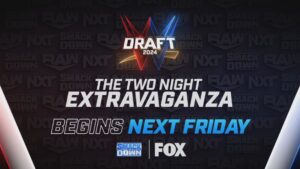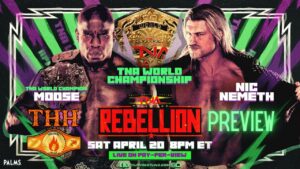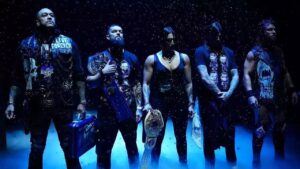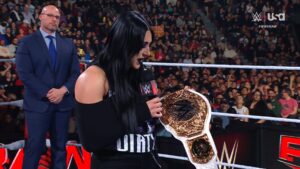All wrestlers have to start somewhere on the path to making their dreams a reality, whether it be a wrestling school, church basement, bingo hall, etc. From there, those wrestlers work their way up to the pinnacle of their dreams. For many, that’s a career in WWE. But sometimes the journey is just as important as the destination. In LWOPW’s newest feature, “Before They Were Famous,” we take a look at the pre-WWE careers of some of the company’s top current stars, following along on their road to superstardom. In this edition, we take a deep dive into the career of Shinsuke Nakamura prior to his World Wrestling Entertainment debut.
Shinsuke Nakamura goes by many names. “The King of Strong Style,” “Swagsuke,” and “The Artist” are just a few of the monikers that the former 5-time IWGP Intercontinental Champion has adopted. Whatever the name, his energy, charisma, and overall presence can’t be denied. His strike-based offense in tandem with his unique aura made him a star in Japan and abroad. His journey to become this larger-than-life talent is nothing short of interesting.
Born on February 24, 1980, in Kyoto, Japan, Shinsuke Nakamura grew up an avid professional wrestling fan. In his book, “King of Strong Style: 1980-2014,” Nakamura recalled learning about the sport largely through the Fire Pro Wrestling video game series. Additionally, he admired such stars as Dean Malenko and Jushin Thunder Liger. He was active in amateur wrestling during high school, where he met future New Japan Pro Wrestling stars Hirooki Goto and Katsuyori Shibata. In 2002, the wrestling career of Nakamura began in New Japan Pro Wrestling.
On August 8, 2002, Shinsuke Nakamura made his debut against former IWGP Heavyweight Champion, Tadao Yasuda.
Also noteworthy was the fact that, around this time, newcomers Nakamura, Shibata, and Hiroshi Tanahashi were dubbed the “New Three Musketeers.” Essentially, they were pegged to lead the company into the future. Nakamura also became known as the “Super Rookie,” facing the likes of Hiroyoshi Tenzan and Yuji Nagata. Later that December, Nakamura made his debut in mixed martial arts, a sport that would have a major influence on his wrestling style.
Nakamura’s first major wrestling accolade occurred on December 9, 2003. On this night, he bested Tenzan for the IWGP Heavyweight Championship. Nakamura became the youngest man in history to hold the prize at 23 years old. To this day, he holds the record. The following year, he successfully defended the title against the likes of Bob Sapp and even unified it with the NWF Heavyweight Championship against Yoshihiro Takayama in January of 2004. Nakamura would have to drop the IWGP Heavyweight Championship that same month due to injury.
The following March, Nakamura returned to NJPW in an exhibition match against Ken Shamrock. Following an unsuccessful IWGP Heavyweight Championship match against Sapp in May, Nakamura set his sights on the 2004 G1 Climax tournament. He performed well, earning 8 points in Block A. Later that winter, Nakamura began teaming with Tanahashi on a regular basis. Their performance as a team led them to the IWGP Tag Team Championship in December. Defeating Kensuke Sasaki and Minoru Suzuki, Nakamura and Tanahashi claimed tag team gold. This marked Nakamura’s first tag team title and Tananashi’s second.
Shinsuke Nakamura started 2005 strong, besting partner Tanahashi for the IWGP U-30 Openweight Championship.
They would be the only to wrestlers to hold the title before it was rendered inactive the following year. Nakamura and Tanahashi continued to defend the IWGP Tag Team Championship throughout 2005, bringing it with them during their excursion to Mexico. Later that October, Nakamura and Tanahashi dropped the title to Black New Japan‘s Tenzan and Masahiro Chono. From there, Nakamura returned to singles competition on a more consistent basis.

On January 4, 2006, Nakamura faced his greatest challenge at that point when he encountered IWGP Heavyweight Champion Brock Lesnar. Keep in mind that Nakamura was not “The King of Strong Style” he would become. Thus, he was soundly defeated by Lesnar. A few months later, Nakamura took part in his second excursion, traveling around the world to gain more skill. What NJPW fans didn’t know, at the time, was that he would also develop a new edge. Gone would soon be “Super Rookie” Nakamura; in his place would be a personality with more of an edge.
The following September, Nakamura returned to NJPW as the newest member of Black New Japan. Leading to this, he went through a “body revamp.” In his book, Nakamura recalled eating up to six or seven meals per day. His goal was to increase weight and muscle mass. A shoulder injury during the 2007 G1 Climax, in August, forced his otherwise successful tournament run to end via referee stoppage; Nakamura earned 7 points in Block B. Nakamura returned later that November to take over leadership of Black New Japan from Chono. From the group in question, Nakamura formed RISE, which also included names like Milano Collection A.T. and Prince Devitt, the former currently known as Finn Balor in WWE.

Nakamura started 2008 with a bang.
At Wrestle Kingdom II, in January, he bested Tanahashi for his second IWGP Heavyweight Championship. Nakamura’s next big victory occurred in February. He successfully challenged Kurt Angle for the Inoki Genome Federation version of the IWGP Heavyweight Championship, resulting in a title unification. Nakamura held the title until April, when he dropped it to Keiji Muto. By the fall, RISE began to slowly disband. This was escalated when Nakamura and Goto were attacked by their stablemates following an unsuccessful IWGP Tag Team Championship match.
Throughout early 2009, RISE soldiered on, though it would not be long for NJPW. Complications developed further when Nakamura unsuccessfully challenged Tanahashi for the IWGP Heavyweight Championship in February. The following April, the stable known as Great Bash Heel, led by Togi Makabe, saw members turning their backs on their leader. They decided to join Toru Yano, who previously betrayed Makabe, and Nakamura, who formed the group called CHAOS. Along with a new finisher – the Bomaye knee strike would replace the Landslide – Nakamura adopted a more villainous persona. The latter would spark the fire that became his trademark charisma.
As the leader of CHAOS, Nakamura developed a hot streak.
In the 2009 G1 Climax, Nakamura won every match of his up to the finals, besting the likes of Tenzan, Goto, and Tanahashi along the way. Speaking of, an injury sustained by Tanahashi forced him to relinquish the IWGP Heavyweight Championship, which Nakamura won for the third time by defeating Makabe in September. Nakamura held onto the title for the rest of the year, securing victories over Nagata, Tanahashi, and Shinjiro Otani. With CHAOS by his side, “The King of Strong Style” was as dangerous and successful as ever.
Nakamura’s hot streak continued into 2010. January saw Nakamura successfully defend the IWGP Heavyweight Championship against Takayama at Wrestle Kingdom IV. Nakamura kept the title until May, when he dropped it to Makabe at Wrestling Dontaku 2010. During the middle of the month, Nakamura took time off to heal his shoulder. He returned the following month at Dominion 6.19, besting Daniel Puder; interestingly, they would team up for the 2010 G1 Tag League tournament later in the fall. August saw Nakamura enter the 2010 G1 Climax, which he ended with 9 points in Block B.
Shinsuke Nakamura was determined to make the most of 2011.
On January 4, he defeated Go Shiozaki at Wrestle Kingdom V. In May, he worked shows for Consejo Mundial de Lucha Libre. It was here that he worked with the likes of Rush and La Sombra, the latter currently known as Andrade in WWE. Nakamura returned to NJPW later that summer. He entered the 2011 G1 Climax, making it to the finals with 14 points in Block B. This led him to the finals against Block A winner, Tetsuya Naito, who he defeated to win the G1 Climax. Nakamura went on to challenge IWGP Heavyweight Champion Tanahashi in September. The following November saw Nakamura having a solid showing in the 2011 G1 Tag League, teaming with Toru Yano to earn 10 points in Block B.
In 2012, Nakamura shifted his goals in terms of title contention. On July 22, Nakamura defeated Goto for the IWGP Intercontinental Championship. This would become the title most closely associated with Nakamura, as his defenses and matches helped to elevate it. Many would argue that, through his efforts, it became just as prestigious as the IWGP Heavyweight Championship. Nakamura attributed his interest in the title after seeing Goto and Tomohiro Ishii wrestle. In his book, Nakamura described the encounter as “Showa feeling,” specifically noting its rugged nature. Throughout 2012, Nakamura successfully defended his new belt against Goto, Karl Anderson, and Oliver John. He also tangled with stablemate Kazuchika Okada, the IWGP Heavyweight Champion at the time; Okada would go on to become the company’s top star in the coming years.
Following a successful Wrestle Kingdom 7 title defense against Kazushi Sakuraba, in January of 2013, Nakamura remained a defending champion. He successfully retained against La Sombra during CMLL Fantastica Mania, in addition to Lance Archer, Davey Boy Smith Jr., and Shelton Benjamin in NJPW. Nakamura’s first IWGP Intercontinental Championship reign ended in May, when he lost to La Sombra; he would regain the belt the following July. This made Nakamura the first man to hold the IWGP Intercontinental Championship on multiple occasions. Nakamura would hold onto the title for the remainder of 2013.

January 4, 2014 saw NJPW hold Wrestle Kingdom 8.
This event was significant in that the IWGP Intercontinental, not the Heavyweight, Championship closed the show. In the main event, voted by the fans to go last, Nakamura defended against Tanahashi, who ended the second reign of “The King of Strong Style.” From there, Nakamura entered that year’s New Japan Cup, which started in March. Ultimately, Nakamura won the tournament, which led him back to the title he lost. At April’s Invasion Attack event, Nakamura bested Tanahashi for his third IWGP Intercontinental Championship.
In May, NJPW and Ring of Honor held War of the Worlds, which brought stars of the two companies together. On the show, Nakamura faced Kevin Steen, the current Kevin Owens in WWE. After an IWGP Intercontinental Championship loss to Bad Luck Fale in June, Nakamura entered the 2014 G1 Climax. Nakamura performed strongly, winning Block A before making it to the finals. Ultimately, he lost to CHAOS stablemate Okada. Nakamura rebounded strongly in September, however, when he bested Bad Luck Fale for his fourth IWGP Intercontinental Championship.
On January 4, 2015, Shinsuke Nakamura defended the IWGP Intercontinental Championship at Wrestle Kingdom 9.
His opponent was Kota Ibushi, who Nakamura defeated in an encounter that lasted over 20 minutes. The match in question was incredibly well-received, even being awarded Match of the Year by The Wrestling Observer Newsletter. Nakamura’s fourth IWGP Intercontinental Championship reign ended in May, at Wrestling Dontaku 2015, at the hands of Goto. Following a strong 2015 G1 Climax performance, Nakamura made it to the finals, where he lost to Tanahashi. September saw Nakamura win his fifth IWGP Intercontinental Championship from Goto at Destruction in Kobe 2015. 2016, however, would prove to be one of the biggest years in the “The King of Strong Style’s” storied career.

Shinsuke Nakamura would end up working his final major NJPW event at Wrestle Kingdom 10 on January 4, 2016. On this night, he successfully defended the IWGP Intercontinental Championship against Bullet Club leader AJ Styles. It was around this time that rumors circulated that they, along with Anderson and Doc Gallows, were WWE-bound; the rumors would later be confirmed by WWE. Nakamura wrestled his final NJPW match on January 30. In an emotional eight-man tag team match, Nakamura teamed with CHAOS stablemates Gedo, Ishii, and Okada against Goto, Tanahashi, Shibata, and Ryusuke Taguchi. Following the match, Nakamura was sent off by NJPW, sitting atop the shoulders of his peers.
Shinsuke Nakamura would go on to make his WWE in-ring debut at NXT TakeOver: Dallas on April 1, 2016.
He wrestled Sami Zayn, who worked his final NXT match that night, in one of the most well-received matches of the year. Since arriving in WWE, Nakamura has become a two-time NXT Champion, two-time United States Champion, one-time Intercontinental Champion, and even won the Royal Rumble match in 2018. Regardless of what he goes on to accomplish in WWE, it’s difficult to deny that Nakamura’s career in Japan alone is worthy of being in any wrestling Hall of Fame.
Stay tuned to the Last Word on Pro Wrestling for more on this and other stories from around the world of wrestling, as they develop. You can always count on LWOPW to be on top of the major news in the wrestling world, as well as to provide you with analysis, previews, videos, interviews, and editorials on the wrestling world.






